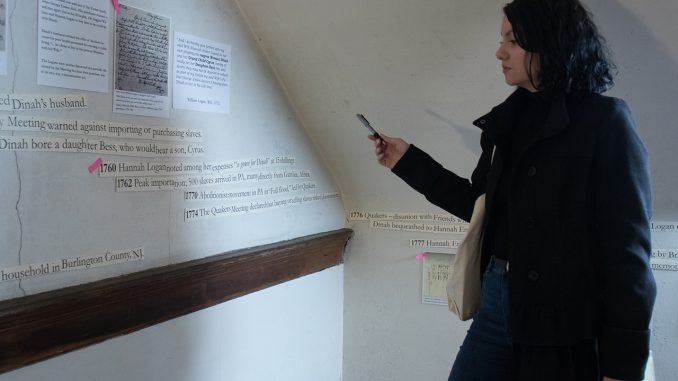
At Stenton, a historic house museum in the Logan neighborhood of Philadelphia, a 1912 memorial plaque for Dinah, a formerly enslaved woman, describes her as a “faithful colored caretaker.”
“It talks about her loyalty to the house and the Logan family but leaves out so much of her life,” said Isabelle Heller, a junior history major. “That’s an issue with a lot of monuments. They tell stories but at the same time create these massive silences, which lead to a sort of false history.”
In a Museum History course last semester, Heller began creating a new monument proposal to Dinah. At the end of the semester, the class submitted their proposals for a new monument to Dinah, which would replace the current memorial plaque. The proposals came as a part of a larger, two-year project from Stenton called “Inequality in Bronze” which focuses on creating a new 21st-century memorial to Dinah to better reflect her life and the reality of slavery around 1607-1776.
Heller fell in love with the research in the class and is now writing her thesis on the project.
“What we wanted to do was to create a monument proposal that provided better context to Dinah’s life and try to fix the issues we saw in the old memorial,” she added.
James Logan, a Scottish-American statesman, served as secretary to William Penn and was the founder and trustee of the University of Pennsylvania. Dinah, who is referred to only by her first name in documents, was enslaved under Logan’s son, William, but was freed in 1776 after the increasing pressure from the Quaker community to abolish slavery, said Tom Snow, a tour guide at Stenton.
Dinah had famously saved Stenton, also known as the James Logan House, from destruction by the British army in 1777. After being granted her freedom, she stayed at Stenton as a paid housekeeper.
The museum looked to the public for memorial project proposals, and three finalists were selected to create the new memorial. The finalists are La Vaughn Belle of the Virgin Islands, Kenturah Davis of Los Angeles and Karyn Olivier, who lives in Philadelphia. The winner will be announced within the coming weeks.
Dinah’s existing memorial plaque was commissioned by the National Society of The Colonial Dames of America, an early women’s organization for individuals’ who trace their ancestry to the Revolutionary War.
“During this time period, white women are making headway in society, while simultaneously pushing down women of color,” Heller said.
Historically, there hasn’t been a strong connection between Stenton and its surrounding community, Snow said.
“If you live in a predominantly African American neighborhood, chances are you don’t care very much about some old white rich guy, in this case, James Logan,” he added. “Hopefully, the new memorial will change that.”
Carla Wiley has reenacted Dinah’s character at Stenton for the past ten years and said communicating her story as a part of the museum’s history to visitors, especially members of the surrounding community, is important.
“When people hear she was enslaved, they sometimes automatically assume she was unintelligent, uneducated and make assumptions about her saving the house of her enslaver,” Wiley said. “But this was her home. She was not simply defending Mr. Logan’s home, but her own.”
Heller thinks the new memorial to Dinah will be a part of a larger movement in the historical community.
“We saw this in the past year with the effort to remove the Frank Rizzo statue downtown, while around the same time creating a monument to Octavius Cato, an African American man who fought for black suffrage in Philadelphia,” she said.



Isabelle Heller’s thesis project to immortalize the memory of Dinah, a slave during the 1600s, resonated quite strongly with some wonderings that I had regarding how history is visually represented in modern day America. Over the past few weeks, a couple thoughts came to mind about how Columbus Day and Indigenous People’s Day fall on the same occasion despite celebrating polar opposite ideals. In front of the Philadelphia art museum, a statue of George Washington towers over bronze replicas of Native American chiefs. As the United States’ political views progress, our monuments and memories rarely change. Heller’s dedication to preserving history as it truly was shows how studying the past can pave a more informed path for the future.
Isabelle Heller’s thesis work, as well as her comments on the statue, are fantastic headway into the larger issue that is the idealization of history. Oftentimes, especially in American history, many great details are left out in order to preserve the “American good spirit.” Historians will pretend that individuals were better off than they truly were to prevent any negative feelings. It is through the work of individuals like Isabelle Heller that our future generations will have updated history books, showing the true nature of our country’s past.
Isabelle Heller did a great job of expressing her passion towards recognizing the memory of Dinah, a slave for the Logan family around 1607-1776. I loved how credible all her sources were and she made sure to explain them clearly and why it was relevant.
This is a profound report on the relevance of women’s unity and it’s lacking presence in the past. This monument will help put Dinah’s story in the spotlight where it belongs.
The attention to detail and dedication that Isabelle has shown to this project is incredibly admirable. Her passion is inspiring and I am excited to see the results!